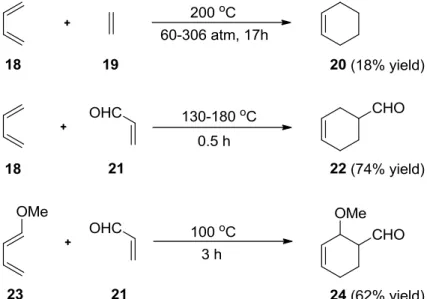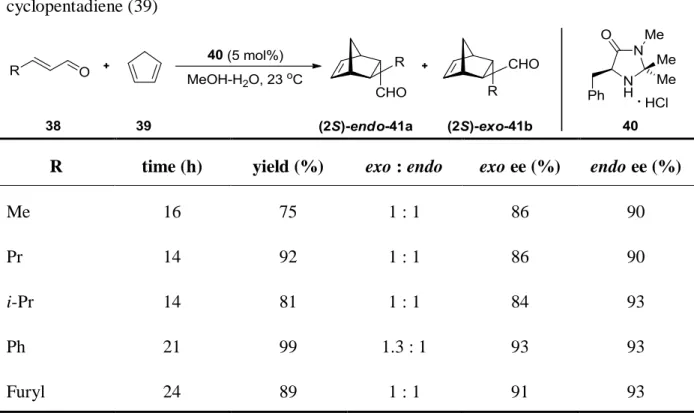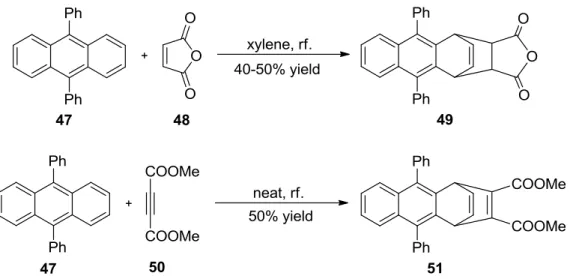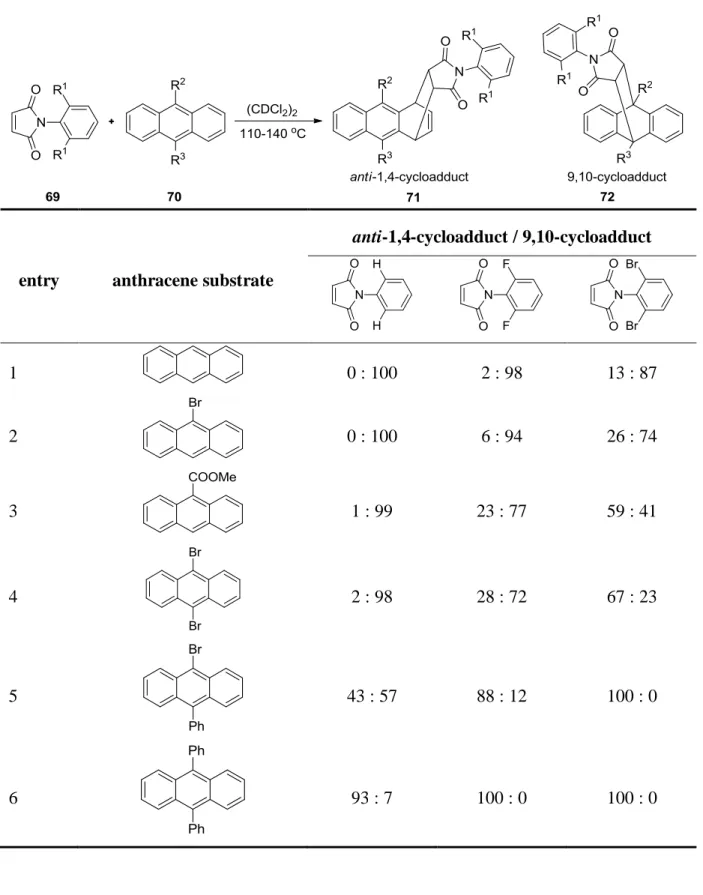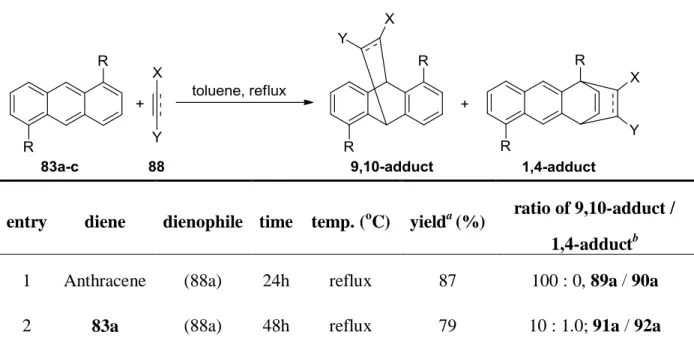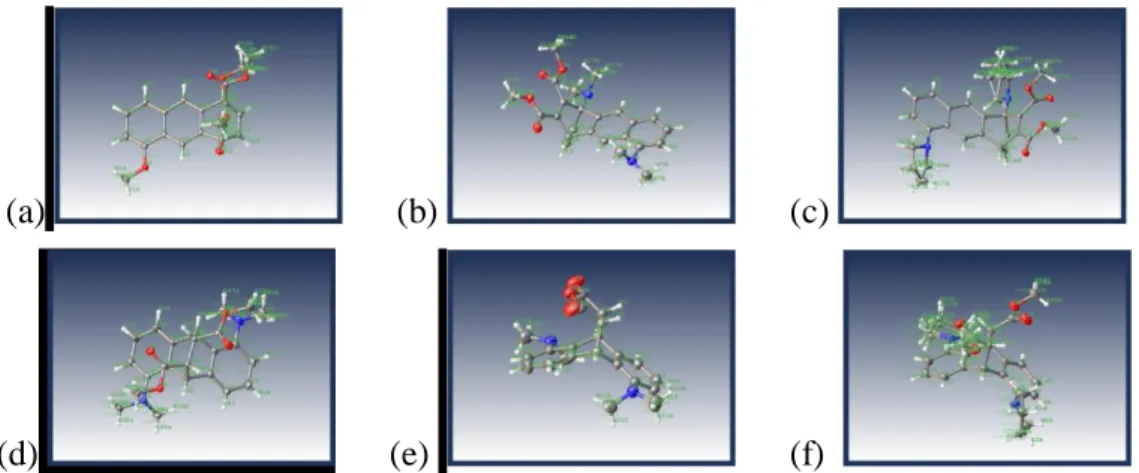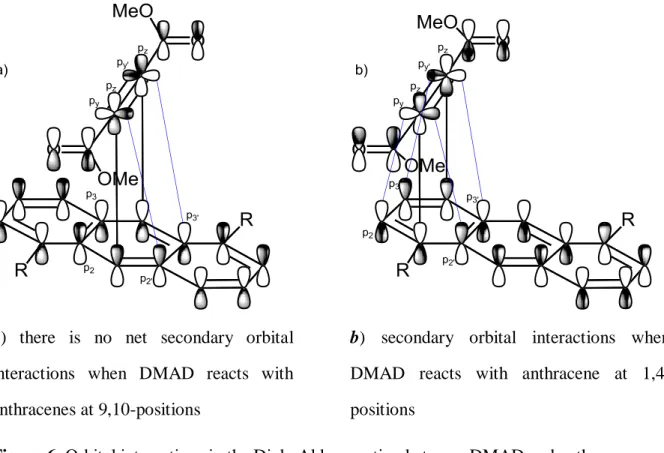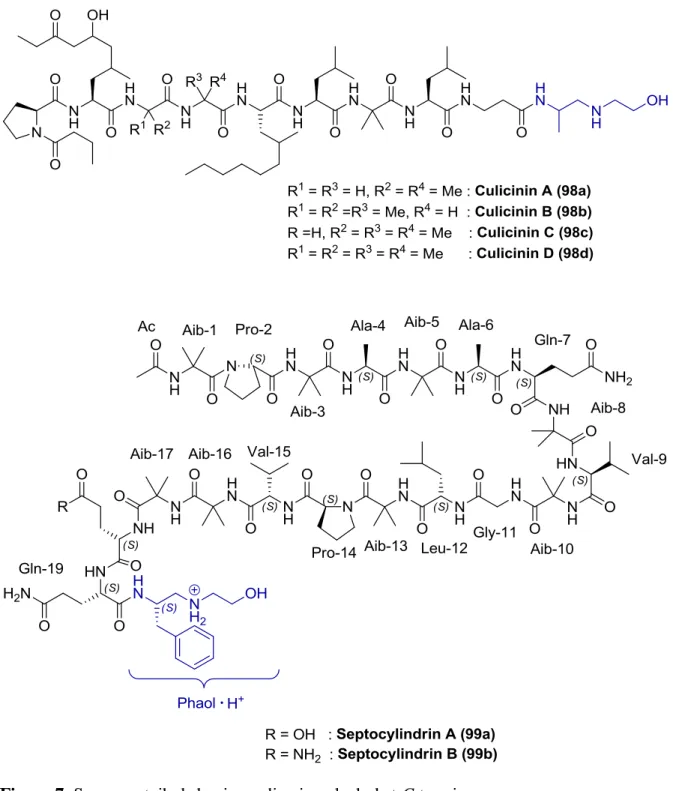1,4-Cycloaddition of Anthracenes and
Practical Method for The Synthesis of Chiral Diamino Alcohols
Dissertation
Zur Erlandung des Doktorgrades Dr. rer. nat
an der Fakultät für Chemie und Pharmazie der Universität Regensburg
vorgelegt von Huynh Ngoc Vinh
aus Ho Chi Minh Stadt (Vietnam)
Regensburg 2017
Die Arbeit wurde angeleitet von: Prof. Dr. Oliver Reiser Promotionsgesuch eingereicht am:
Promotionskolloquium am:
Prüfungausschuss: Vorsitz: Prof. Dr. Armin Buschauer 1. Gutachter: Prof. Dr. Oliver Reiser
2. Gutachter: Prof. Dr. Axel Jacobi von Wangelin
3. Prüfer: Prof. Dr. Arno Pfitzner
Der exprimentelle Teil der vorliegenden Arbeit wurde in der Zeit von März 2010 bis September 2014 unter der Leitung von Prof. Dr. Oliver Reiser am Institut für Organische Chemie der Universität Regensburg, Regensburg, Deutschland
Herrn Prof. Oliver Reiser möchte ich herzlich für die Überlassung des äußerst interessanten
Themas, die anregenden Diskussionen und seine stete Unterstützung während der
Durchführung dieser Arbeit danken.
Meinen Eltern
Table of Contents
Abbreviations
Part I: 1,4-Cycloaddition of Anthracenes
1. Introduction 1
1.1. Diels-Alder reaction 1
1.2. 1,4-cycloaddition of anthracenes 8
1.2.1. Using steric and electronic factors in substituted anthracenes to favor the formation
of the 1,4-cycloadduct 9
1.2.2. Using molecular host to obtain 1,4-cycloadducts of anthracenes 14
2. Aim of the work 16
3. Synthesis of starting materials 17
4. The Diels-Alder reaction of anthracenes (83a-c) 19 Part II: A Practical Method for the Synthesis of Chiral Diamino Alcohols
5. A practical method for the synthesis of chiral diamino alcohols 24
5.1. Introduction 24
5.1.1. Synthesis of diamino alcohols by the reduction of dipeptides 26 5.1.2. Synthesis of diamino alcohol by the coupling of two amino alcohols 29
5.2. Aim of the work 32
5.3. The synthesis of diamino alcohols 154 34
5.3.1. The synthesis of 2-imidazolines 34
5.3.2. The hydrolysis of 2-imidazolines 163 38
6. The diamino alcohol 154i catalyze the Michael reactions of 2-nitropropane 41
6.1. The Michael reaction of nitroalkanes to α,β-unsaturated enones: an introduction 41
6.2. Aim of the work 44
6.3. The catalytic activity of the compound 154i in the asymmetric Michael reaction 46 7. 2-Imidazolidines catalyze the Morita-Baylis-Hillman reaction 49 7.1. The Morita-Baylis-Hillman reaction: introduction and mechanism 49 7.2. The asymmetric Morita-Baylis-Hillman reaction with chiral catalysts 57 7.2.1. The asymmetric catalytic MBH reaction of acrylates 58 7.2.2. The asymmetric catalytic MBH reaction of methyl vinyl ketone or acrolein 60 7.2.3. The asymmetric catalytic MBH reaction of cyclopentenone and cyclohexenone 61
7.3. Aim of the work 63
7.4. Catalytic activities of imidazolines 253a-b 64
7.4.1. Synthesis of imidazolines 253a-b 64
7.4.2. Catalytic activities of the 2-imidazolines 253a-b in the MBH reaction 65
8. Summary 74
8.1. 1,4-Cycloaddition of anthracenes 74
8.2. A practical method for the synthesis of diamino alcohols 75
9. Experimental part 78
9.1. General comments 78
9.2. Diels-Alder reaction of anthracene compounds (83a-c) 80
9.3. Preparation of diamino alcohols 154a-k 92
9.3.1. General procedure for the preparation of hydroxy amides 162 92
9.3.2. General procedure for the preparation of 2-imidazolines 163 94
9.3.3. General procedure for the preparation of diamino alcohol 154 101
9.4. Application of compound 154i in the asymmetric Michael reaction 110 9.5. Application of 253a and 253b in the Morita-Baylis-Hillman reaction 114
9.5.1. Synthesis of imidazolines 253a, 253b, and 274 114
9.5.2. The MVK-based Morita-Baylis-Hillman reaction catalyzed by 253b 120
10. References 122
11. Appendix 154
11.1. NMR-spectra 154
11.2. X-ray structure and data 209
Acknowledgement
Curriculum vitae
Abbreviations
Abbreviations
9-BBN 9-borabicyclo[3.3.1]nonane EWG Electron-Withdrawing Group
atm atmosphere Fc ferrocenyl
BA Brønsted Acids h hour
Bn benzyl Hal halogen
Boc tert-butyloxycarbonyl HOMO High Occupied Molecular Orbital
Cat. catalyst HPLC High-Performance Liquid
Chromatography
Cbz carboxybenzyl HRMS High-resolution mass
spectroscopy DABCO 1,4-diazabicyclo[2.2.2]octane IR infra-red
DCM dichloromethane LA Lewis Acid
DMAD dimethylacetylenedicarboxylate LUMO Low Unoccupied Molecular Orbital
DMAP dimethylaminopyridine m- meta-
DMF dimethyl formamide M metal
EDG Electron-Donating Group Me methyl
ee enantiomeric excess min minute
equiv. equivalent Mp. melting point
ESI-MS Electrospray Ionization Mass Spectroscopy
MS Molecular Sieves
Abbreviations
Et ethyl MS/MS Tandem Mass Spectroscopy
NMR Nuclear Magnetic Resonance rf. reflux
p- para- OAc acetate
PE Petroleum Ether OTf trifluoromethanesulfonate or
triflate
PG Protecting Group OTs p-toluenesulfonate
Ph phenyl temp. temperature
Phe phenylalanine THF tetrahydrofuran
i
Pr iso-propyl UV ultraviolet
Red-Al sodium bis(2-
methoxyethoxy)aluminum hydride
X arbitrary anion
Part I:
1,4-Cycloaddition of Anthracenes
1,4-cycloaddition of anthracenes
1. Introduction
1.1. Diels-Alder reaction
The Diels-Alder reaction
1is a cycloaddition reaction. In this reaction, four π electrons from a conjugated diene 1 and two π electrons from a dienophile 2 (double or triple bond), combine to form two new σ bonds between the diene and the dienophile and one new π bond on the carbon skeleton of the diene (Scheme 1). The reaction is not limited to all carbon substrates. When one or more heteroatoms are involved, this reaction is called hetero-Diels- Alder reaction,
2which is useful for synthesizing six-membered heterocycles. The heteroatom can be in the diene, for example as shown in 4, or can be in the dienophile, as shown in 6.
Scheme 1. The Diels-Alder reactions
The Diels-Alder reaction is usually reversible.
3The reverse reaction which is called retro-Diels-Alder reaction occurs at a higher temperature than the forward reaction. An example that makes use of the retro-Diels-Alder reaction is the synthesis of chiral ,β- unsaturated γ-lactams 10 by using the chiral-substituted anthracene 8 as a chiral auxiliary (Scheme 2).
4Dienes can be cyclic or acyclic but the two double bonds of dienes must be conjugated
and must be able to obtain a cisoid conformation as in 11, 12 or 13 (Figure 1).
1c,5If the two
double bonds of dienes are fixed in a transoid conformation as depicted in 14 (Figure 1), the
Diels-Alder reaction cannot happen.
1,4-cycloaddition of anthracenes
Scheme 2. The asymmetric synthesis of chiral ,β-unsaturated γ-lactams
Figure 1. Possible conformations of conjugated dienes
There is much evidence that the Diels-Alder reaction proceeds in a concerted fashion.
6This reaction takes place in one step in which two new σ bonds are formed simultaneously, so no rotation about single bonds can happen. Consequently, the Diels-Alder reaction is a stereospecific reaction with syn-addition. Substituents on the dienophile which are cis to each other will be cis (syn) on the newly formed ring (A-B and C-D). Similarly, substituents on the dienophile which are trans to each other will be trans (anti) on the newly formed ring (A-D and B-C) (Scheme 3).
Scheme 3. Syn-addition in Diels-Alder reactions
Most dienophiles in the Diels-Alder reaction carry an activating group, or they cannot
react smoothly and readily. The Diels-Alder reaction between butadiene (18) and ethylene
(19) takes place at high temperature (200 °C), high pressure, and requires a long reaction time
1,4-cycloaddition of anthracenes
(17h).
7When there is an electron-withdrawing group (EWG), for example, with acrolein (21) the reaction occurs at a lower temperature (130 °C), and less time (Scheme 4).
8The reaction is even faster when there is an electron-donating group (EDG) on the diene, for example, 1- methoxybutadiene (23), as well as an electron-withdrawing group on the dienophile such as acrolein (21) (Scheme 4).
9This phenomenon can be explained by considering frontier molecular orbitals. The electron-withdrawing group on the dienophile lowers its LUMO energy, while the electron-donating group on the diene increases its HOMO energy. Thus, the energy gap between the HOMO of diene and the LUMO of dienophile decreases, resulting in an acceleration of the reaction (Figure 2a). In this case, we have a normal-electron-demand Diels-Alder reaction. Schubert et al.
10showed a good correlation between the HOMO
diene/LUMO
dienophileseparations and the reactivity. The smaller the energy gap between the HOMO and the LUMO, the faster the reaction. The energy separation between the HOMO and the LUMO can also be lowered by putting an electron-withdrawing group on the diene and putting an electron-donating group on the dienophile. The electron-withdrawing group lowers the LUMO energy of the diene, whereas the electron-donating group moves the HOMO energy of the dienophile to a higher level. In this case, we have an inverse-electron- demand Diels-Alder reaction
1d,11(Figure 2b).
Substituents affect not only the rate but also the regioselectivity in Diels-Alder
reactions. Diels-Alder reactions of unsymmetrically substituted dienes and unsymmetrically
substituted dienophiles can produce different regioisomeric products. For example, the Diels-
Alder reaction of 1-phenylbutadiene (25) and methyl acrylate (26) gives the ortho-adduct 27a
rather than the meta-adduct 27b, while the reaction of 2-phenylbutadiene (28) and methyl
acrylate (26) preferably leads to the para-adduct 29a to the meta-adduct 29b (Scheme 5). The
regioselectivity in the Diels-Alder reaction can be explained by analyzing the coefficients of
the atomic orbitals in the decisive pair of frontier orbitals, i.e. the HOMO/LUMO pair with
the smaller energy gap, being involved in the reaction.
1d,12The major product is formed from
the interaction of the decisive pair of frontier orbitals in the way that the atomic orbitals which
have the larger coefficient on each component interact together and the atomic orbitals which
1,4-cycloaddition of anthracenes
have the smaller coefficient on each component interact together (as described in 30, Scheme 5). Although the ortho- or the para-adduct is usually the major product (the ortho-para rule), in some cases the meta-adduct is mainly formed because of steric effects as in the reaction of piperylene (31) with vinyl-9-BBN 32 (Scheme 6).
13Scheme 4. Effects of substituents on Diels-Alder reactions
Figure 2. Normal-electron-demand and inverse-electron-demand Diels-Alder reactions
1,4-cycloaddition of anthracenes
Scheme 5. The regioselectivity in Diels-Alder reactions
Scheme 6. The exception meta-adduct in the Diels-Alder reaction
Besides the ortho-para rule as described above, the Diels-Alder reaction has another rule, i.e. endo or Alder rule.
1d,14With substituted dienophiles, the Diels-Alder reaction can go through two geometrically different transition states to afford two isomeric adducts: the endo- (usually the major adduct under kinetic conditions) and the exo-adduct (usually the major adduct under thermodynamic conditions). For example, the addition to cis,cis-1,4-dideuterio- 1,3-butadiene (34) of maleic anhydride (35) leads to an 85:15 mixture of the endo-adduct 36 and the exo-adduct 37 (Scheme 7).
15The endo-adduct is kinetically more favorable due to secondary orbital interactions in
the endo-transition state being, however, sterically more crowded.
16Thus, given the
reversibility of the Diels-Alder reaction, the exo-adduct typically forms under thermodynamic
conditions, i.e. extended heating. Later the concept of secondary orbital interactions was
challenged by Salvatella et al.
171,4-cycloaddition of anthracenes
Scheme 7. The endo-selectivity in the Diels-Alder reaction
Solvents have a little effect on the rate of the Diels-Alder reaction, being a signature of concerted reactions. However, both experimental and theoretical studies showed that an increase of polarity of solvents increases the endo/exo ratio of this reaction.
18Diels-Alder reactions exhibited a largely negative activation volume which is a signature of concerted reactions and a largely negative reaction volume which is a signature of addition reactions.
6cBoth characteristics can be utilized to accelerate the reaction and to improve the endo-selectivity by applying high pressure.
9,19Diels-Alder reactions do not often need catalysts. Nevertheless, this reaction can be catalyzed by Lewis acids (LA) or Brønsted acids (BA). These catalysts coordinate to basic sites in dienophiles to lower the LUMO energy of dienophiles (Figure 3), generally allowing running the reaction at lower temperatures. In this way, the regioselectivity and diastereoselectivity can be improved (enhance the endo/exo ratio) and in the case of chiral catalysts, also the enantioselectivity.
2c,2d,20Lewis acids are effective catalysts especially when the activating group on dienophile is a C=O or C=N.
21Figure 3. Lewis acid activation dienophile
1,4-cycloaddition of anthracenes
In addition to Lewis acids and Brønsted acids, small organic molecules known as organocatalysts are good alternatives to produce Diels-Alder adducts with high enantioselectivities. The MacMillan group
22designed the chiral imidazolidinone 40 which catalyzes Diels-Alder reactions and affording cycloadducts in good yields and high stereoselectivities (Table 1).
In contrast to Lewis acid, the catalyst 40 forms covalent bonds with the dienophile 42 and resulting in an iminium ion 43, having a lower LUMO energy level compared to the corresponding carbonyl compound (Scheme 8).
Table 1. The organocatalyzed Diels-Alder reaction between dienophiles 38 and cyclopentadiene (39)
R time (h) yield (%) exo : endo exo ee (%) endo ee (%)
Me 16 75 1 : 1 86 90
Pr 14 92 1 : 1 86 90
i-Pr 14 81 1 : 1 84 93
Ph 21 99 1.3 : 1 93 93
Furyl 24 89 1 : 1 91 93
1,4-cycloaddition of anthracenes
Scheme 8. The proposed mechanism for organocatalyzed Diels-Alder reactions
1.2. 1,4-cycloaddition of anthracenes
Anthracene (46), a compound in coal tar, was discovered by Dumas and Laurent in 1832.
23Because of the largest coefficients in the HOMO of (46) (Scheme 9)
24and the smaller aromaticity loss during the reaction at the center ring (8 kcal/mol compared to 20 kcal/mol in the outer rings),
25Diels-Alder reactions of anthracenes furnish 9,10-cycloadducts rather than 1,4-cycloadducts (Scheme 9). Only a few exceptions for Diels-Alder reactions that take place at 1,4-positions have been reported. In principle, there are two ways to favor the 1,4- cycloadduct in Diels-Alder reactions of anthracenes, i.e. disfavoring the 9,10-positions for the cycloaddition by steric or electronic factors.
Scheme 9. Orbital coefficients in the HOMO and possible [4+2]-cycloadditions of anthracene
(46)
1,4-cycloaddition of anthracenes
1.2.1. Using steric and electronic factors in substituted anthracenes to favor the formation of the 1,4-cycloadduct
Cook et al.
26found that anthracenes which have bulky groups at the 9,10-positions like 9,10-diphenylanthracene (47) undergo the unusual 1,4-cycloaddition with maleic anhydride (48) to furnish the 1,4-cycloadduct 49 exclusively instead of the normal 9,10- cycloadduct (Scheme 10). Likewise, when the dienophile is dimethyl acetylenedicarboxylate (DMAD) (50), only the 1,4-cycloadduct 51 is found in the reaction of 9,10- diphenylanthracene as well (Scheme 10).
27Bulky groups both at 9- and at 10-positions are crucial to obtain exclusively the 1,4-cycloadduct 49. For example, when 9-bromo, 9-chloro or 9-nitro-10-phenylanthracene is employed, both 9,10- and 1,4-cycloadducts are formed.
Benzyne (52) is a particular reactive dienophile. Klanderman et al.
28reported that it reacts with anthracenes both at 1,4- and 9,10-positions. The results (Table 2) show that when electron-donating groups are introduced into the terminal rings (entry 4-6, Table 2) or the center ring carries electron-withdrawing groups (entry 8 and 9, Table 2) or bulky groups (entry 9 and 10, Table 2), the ratio of 1,4-cycloadduct/9,10-cycloadduct is increased.
However, no anthracene substrate gives the 1,4-cycloadduct exclusively. The highest 1,4- cycloadduct/9,10-cycloadduct ratio is found in the reaction employing 9,10- diphenylanthracene (entry 10, Table 2).
Instead of using two phenyl groups, Nikitin et al.
29used ferrocenyl groups to control
the regioselectivity in the Diels-Alder reaction of anthracenes. The reactions of 9-
ferrocenylanthracene (56) with benzoquinone, N-methyl maleimide, N-phenyl maleimide,
DMAD, 4,5-dimethylbenzyne (57), benzyne (52) give exclusively 9,10-cycloadducts, for
example, the compound 58. In contrast, with tetrafluorobenzyne (59) as dienophile 9-
ferrocenylanthracene gives 60 and 61 as an equimolar mixture of 9,10- and 1,4-cycloadducts
(Scheme 11). The exclusive 1,4-cycloaddition can be achieved when the second ferrocenyl
group is introduced to the 10-position such as 62, but the reactivity of 62 is significantly
diminished. DMAD and 3-trifluoromethylbenzyne (64) react exclusively at the 1,4-positions
1,4-cycloaddition of anthracenes
of 9,10-diferrocenylanthracene, while benzyne (52) and 3-fluorobenzyne (67) undergo 9,10- cycloaddition (Scheme 12). N-methyl maleimide gives a mixture of 1,4- and 9,10- cycloadducts.
Scheme 10. 1,4-cycloadducts in the Diels-Alder reaction of 9,10-diphenylanthracene (47)
Table 2. The reactivity of benzyne toward anthracenes
entry anthracene substrate 9,10-cycloadduct/1,4-cycloadduct
1 9,10-Dimethylanthracene ~200
2 9-Methylanthracene ~70
3 9,10-Dimethoxyanthracene 28
4 1,4-Dimethylanthracene 13.0
1,4-cycloaddition of anthracenes
entry anthracene substrate 9,10-cycloadduct/1,4-cycloadduct
5 2,6-Dimethylanthrancene 14.0
6 1,4-Dimethoxyanthracene 2.5
7 Anthracene 30
8 9-Cyanoanthracene 3.7
9 9-Nitroanthracene 4.3
10 9,10-Diphenylanthracene 0.08
11 9,10-dicyanoanthracene 1.0
Scheme 11. The cycloaddition of 9-ferrocenylanthracene
1,4-cycloaddition of anthracenes
Scheme 12. The cycloaddition of 9,10-diferrocenylanthracene
Recently, Ma et al.
30used maleimide with a bulky group on the nitrogen atom to
obtain 1,4-cycloadducts. The strong steric interactions between bulky dienophiles 69 and
bulky dienes 70 suppress the 9,10-cycloaddition in favor for the anti-1,4-cycloaddition. The
results in Table 3 show that N-phenylmaleimides bearing bulky substituents at the ortho-
position and again anthracenes carrying two bulky substituents at 9,10-positions would give
the highest 1,4-cycloadduct/9,10-cycloadduct ratio. Because of the steric effect, only anti-1,4-
cycloadducts are found. The authors also mentioned that electron-withdrawing groups on the
center ring motivate the reaction to give 1,4-cycloadducts, but steric effects are always the
dominating factor in giving the highest 1,4-cycloadduct/9,10-cycloadduct ratio.
1,4-cycloaddition of anthracenes
Table 3. Diels-Alder reactions between different steric N-phenylmaleimides 69 and anthracenes 70
entry anthracene substrate
anti-1,4-cycloadduct / 9,10-cycloadduct
1 0 : 100 2 : 98 13 : 87
2 0 : 100 6 : 94 26 : 74
3 1 : 99 23 : 77 59 : 41
4 2 : 98 28 : 72 67 : 23
5 43 : 57 88 : 12 100 : 0
6 93 : 7 100 : 0 100 : 0
1,4-cycloaddition of anthracenes
1.2.2. Using molecular host to obtain 1,4-cycloadducts of anthracenes
In 2006, the Fujita group
31designed the molecular host 75 which could catalyze Diels- Alder reactions of anthracenes 73 with N-cyclohexylmaleimide (74) in water to afford 1,4- cycloadducts. Because of the limited space of the cavity in the molecular host 75, N- cyclohexylmaleimide (74) has to locate near the terminal ring (1,4-positions), explaining that only syn-1,4-cycloadducts are formed (Scheme 13) regardless of the higher π-electron density at the center ring. As we have seen before, the introduction of substituents at 9- and/or 10- position of the anthracene framework would lead to the 1,4-cycloadduct at high yields, thereby producing of 76, 77, 78, and 79 at high yields. Although the 1,4-cycloadduct 80 is formed in moderate yield (55%), up to now, it is the highest yield for the 1,4-cycloaddition of 9,10-unsubstitued-anthracenes. The bulkiness of the substituent on the nitrogen atom of maleimide is the key factor for the 1,4-cycloaddition. When the cyclohexyl group in N- cyclohexylmaleimide is replaced by a phenyl group, only 9,10-cycloadducts are formed.
Scheme 13. Diels-Alder reactions of anthracenes within the molecular host leading to syn-
1,4-cycloadducts
1,4-cycloaddition of anthracenes
Conclusion: The Diels-Alder reaction proceeds with the high stereoselectivity via a syn-
cycloaddition (cis-principle) as a result of the concerted reaction mechanism, and this reaction
preferentially produces the endo-cycloadduct (endo-rule) as a result of secondary orbital
interactions. The rate and the regioselectivity are controlled by frontier molecular orbitals of
reactants. In anthracenes, the π-electrons concentrate at the center ring (the highest
coefficients of frontier molecular orbital are at the 9- and 10-positions), which induces the
9,10-cycloaddition instead of the 1,4-cycloaddition. There are, however, two ways to obtain
1,4-cycloadducts: a) introducing bulky groups at the 9- and/or 10-position of the anthracene
ring; b) using a molecular host to make dienophiles locate near the terminal ring so that the
1,4-cycloaddition can happen.
1,4-cycloaddition of anthracenes
2. Aim of the work
As we have seen so far, the 1,4-cycloadduct/9,10-cycloadduct ratio can be adjusted by introducing either electron-withdrawing groups or bulky groups to the 9- and/or 10-position of anthracenes and the latter always leads to the highest 1,4-cycloadduct/9,10-cycloadduct ratio. Entry 4, 5, and 6 in Table 2 show that when electron-donating groups are introduced to the terminal rings, the amount of 1,4-cycloadduct is increased but not so high. The formation of both 1,4- and 9,10-cycloadducts leads to difficulties in separating of cycloadducts
32. Until now, we have seen that introducing bulky substituents on the center ring besides using a molecular host is the key factor to get the exclusive 1,4-cycloadduct. We wonder how much the amount of the 1,4-cycloadduct is formed when the terminal rings are introduced stronger electron-donating groups, i.e. N,N-dialkylamino groups. Can these strongly electron-donating groups on the terminal rings of anthracenes promote the creation of the 1,4-cycloadduct exclusively?
The aim of this work is to investigate the Diels-Alder reaction of 1,5-bis(N,N- dimethylamino)anthracene and 1,5-bis(pyrrolidin-1-yl)anthracene which are synthesized from the available compound, i.e. 1,5-diamino-9,10-anthraquinone.
1,4-cycloaddition of anthracenes
3. Synthesis of starting materials
The retrosynthesis of starting materials 1,5-dimethoxyanthracene (83a) and 1,5- bis(dimethylamino)anthracene (83b) is shown in Scheme 14.
Scheme 14. The retrosynthesis of starting materials (83a) and (83b)
1,5-dihydroxy-9,10-anthraquinone (81a) was converted into 1,5-dimethoxy-9,10- anthraquinone (82a) in 78% yield by using dimethyl sulfate in acetone in the present of K
2CO
3(Scheme 15).
33The reductive aromatization of (82a) was accomplished by treatment with an excess amount of sodium borohydride in refluxing isopropanol for two days to afford (83a) in 64% yield (Scheme 15).
34Scheme 15. The preparation of 1,5-dimethoxyanthracene
1,8-bis(dimethylamino)anthracene (86) was synthesized in 49% yield over two steps
(Scheme 16)
35, so the same procedure was applied to synthesize 1,5-
bis(dimethylamino)anthracene (83b).
1,4-cycloaddition of anthracenes
Scheme 16. The synthesis of 1,8-bis(dimethylamino)anthracene
The methylation of 1,5-diamino-9,10-anthraquinone (81b) with methyl iodide and sodium hydride in THF afforded 1,5-bis(dimethylamino)-9,10-anthraquinone (82b) in 66%
yield. However, the reduction of (82b) gave 1,5-bis(dimethylamino)anthracene (83b) in 28%
yield (Scheme 17) due to the steric hindrance of dimethylamino groups.
Scheme 17. The synthesis of 1,5-bis(dimethylamino)anthracene
A modified procedure was suggested to obtain (83b) in a higher yield. To avoid the steric hindrance of dimethylamino group in the reduction step, (81b) was reduced to 1,5- diaminoanthracene (87) in 78% yield
36and then the 1,5-diaminoanthracene was methylated to give (83b) in 63% yield (Scheme 18). The analogous compound 1,5-bis(pyrrolidin-1- yl)anthracene (83c) was similarly synthesized in 51% yield (Scheme 18).
Scheme 18. The synthesis of 1,5-bis(dialkylamino)anthracenes
1,4-cycloaddition of anthracenes
4. The Diels-Alder reaction of anthracenes (83a-c)
These three anthracene compounds (83a-c) were employed in Diels-Alder reactions with such dienophiles as dimethyl acetylenedicarboxylate (DMAD, 88a), methyl phenylpropiolate (88b), dimethyl fumarate (88c), and maleic anhydride (88d) (Table 4), however, in all cases, 9,10-cycloadducts were formed exclusively except DMAD. A mixture of 1,4- and 9,10-cycloadducts (91a / 92a = 10 : 1, Scheme 19) was observed in the reaction of DMAD and 1,5-dimethoxyanthrancene (81a). With the dimethylamino substituted anthracene (83b), the 1,4-cycloadduct 94a became the major product (93a / 94a = 1 : 2.4, Scheme 19).
Steglich et al.
37demonstrated that 4-pyrrolidinopyridine is more nucleophilic than dimethylaminopyridine (DMAP) due to the reduced steric demand of the pyrrolidine group resulting in a more efficient orbital interaction of the lone pair on nitrogen with the pyridine moiety. Following the lead of Steglich et al., the anthracene (83c), which was assumed that the electron density in the terminal rings would be further increased, was next investigated.
We were pleased to find that the reaction between (83c) and DMAD indeed yielded the 1,4- cycloadduct 96a exclusively (Scheme 19).
Table 4. The Diels-Alder reactions of 9,10-unsubstituted anthracenes
entry diene dienophile time temp. (
oC) yield
a(%) ratio of 9,10-adduct / 1,4-adduct
b1 Anthracene (88a) 24h reflux 87 100 : 0, 89a / 90a
2 83a (88a) 48h reflux 79 10 : 1.0; 91a / 92a
1,4-cycloaddition of anthracenes
entry diene dienophile time temp. (
oC) yield
a(%) ratio of 9,10-adduct / 1,4-adduct
b3 83b (88a)
24h 24h
reflux 80
78 19
b1.0 : 2.38; 93a / 94a 1.0 : 2.54; 93a / 94a
4 83b (88b) 72h reflux 19 100 : 0; 93b / 94b
5 83b (88c) 24h reflux 78 100 : 0; 93c / 94c
6 83b (88d) 0.5h reflux 88 100 : 0; 93d / 94d
7 83c (88a) 24h reflux 78 1 : >99; 95a / 96a
8 83c (88b) 72h reflux 23 100 : 0; 95b / 96b
9 83c (88c) 24h reflux 86 100 : 0; 95c / 96c
10 83c (88d) 0.5h reflux 75 100 : 0; 95d / 96d
Reactions were carried out with 200 mg of diene and 1.1 equiv. of dienophile in toluene (0.5M) in seal tubes at 150
oC.
aIsolated yield.
bdetermined by
1H NMR integration
Scheme 19. The effect of electron-donating groups on the regioselectivity
The structures of 92a, 94a, 96a were assigned by NMR spectroscopic experiments and
were confirmed by the single crystal X-ray diffraction analysis (Figure 4).
1,4-cycloaddition of anthracenes
(a) (b) (c)
(d) (e) (f)
Figure 4. Crystal structure of (a) 92a, (b) 94a, (c) 96a, (d) cis-93c, (e) 93d, (f) trans-95c
Under reflux condition with toluene for 24 hours or in a microwave oven at 163
oC for 1h, the 9,10-cycloadduct 93a did not cross over to the 1,4-cycloadduct 94a and vice versa.
Entry 3 in Table 4 showed that the reaction temperature gave no significant change in the ratio of 1,4- and 9,10-cycloadducts. So 1,4- and 9,10-cycloadducts are both kinetically and thermodynamically preferred in the current reaction condition.
Explanation the 1,4-cycloaddition of anthracenes (83a-c) and DMAD
The orbital coefficients of the HOMO of (83b) predicted that the 9,10-attack is still
preferred. Dienophiles have double bond such as (88c) and (88d) have to approach the
anthracene rings in the way that the double bond plane of dienophiles is parallel to the
anthracene plane. When these dienophiles react with the anthracenes at 9,10-positions, the
secondary orbital interaction will assist the construction of the second phenyl ring and to form
the 9,10-cycloadduct (Figure 5a). This interaction does not exist when these dienophiles react
at 1,4-positions (Figure 5b). Therefore, the 9,10-cycloaddition is still preferred with
dienophiles (88c) and (88d). Dienophiles have triple bond such as benzynes should approach
the anthracene ring perpendicularly to reduce the steric interaction between the substituents
on dienophiles and the anthracene ring. However, DMAD can approach the anthracene ring
parallel or perpendicularly to the plane of anthracene ring so that the steric interaction
between its substitutions and the anthracene ring is minimized. In Figure 6b, when DMAD
1,4-cycloaddition of anthracenes
reacts with anthracenes at 1,4-positions, the secondary orbital interactions between p
yand p
2, p
2’and between p
y’and p
3, p
3’are developed on both sides. In contrast, when DMAD reacts with anthracenes at 9,10-positions, the secondary orbital interactions between p
yand p
2, p
2’and between p
y’and p
3, p
3’are developed on one side and are canceled on the other side (Figure 6a). Therefore, when there is an electron-donating group on the terminal ring of anthracenes, the 1,4-cycloadduct can be formed and the stronger the electron-donating group (pyrrolidin-1-yl>dimethylamino>methoxy≫hydrogen) on the terminal ring, the more amount of the 1,4-adduct is formed as shown in Scheme 19. However, when the volume of dienophiles increases from DMAD to methyl 3-phenylpropiolate (88b), the 9,10-cycloadduct will be preferred (entry 3 vs. entry 4 and entry 7 vs. entry 8 in Table 4) and the yield is dropped because this dienophile is less electrophilic and more steric than DMAD.
a) secondary orbital interactions when (88d) reacts with anthracenes at 9,10- positions
b) there is no net secondary orbital interactions when (88d) reacts with anthracenes at 1,4-positions
Figure 5. Orbital interactions between anhydride maleic acid and anthracenes
1,4-cycloaddition of anthracenes
a) there is no net secondary orbital interactions when DMAD reacts with anthracenes at 9,10-positions
b) secondary orbital interactions when DMAD reacts with anthracene at 1,4- positions
Figure 6. Orbital interactions in the Diels-Alder reaction between DMAD and anthracenes
Conclusion:
Although the high localization of the π-electron density at the center ring, the formation of an adduct bridging the terminal ring (1,4-cycloadduct) of anthracenes occurs with a) anthracenes have strong electron-donating groups on terminal rings. The stronger the electron-donating group on the terminal ring, the higher the 1,4-cycloadduct/9,10-cycloadduct ratio; b) small highly reactive dienophiles have a triple bond, for example, benzynes or DMAD.
DMAD reacted with anthracene (83c) gave exclusively 1,4-cycloadduct in 78% yield.
It is the highest yield, up to now, for the 1,4-cycloadditon of 9,10-unsubstituted anthracenes.
Part II:
A Practical Method for the Synthesis of Chiral Diamino
Alcohols
A practical method for the synthesis of chiral diamino alcohols
5. A practical method for the synthesis of chiral diamino alcohols
5.1. Introduction
Diamino alcohols are present at the C-terminus of some peptaibols which are short
polypeptides containing a large amount of the marker -aminoisobutyric acid (Aib), for
example, Aibellin, Culicinin A-D, Septocylindrin A and Septocylindrin B (Figure 7).
38Peptaibols possess interesting biological activities such as antibacterial, antifungal, antiviral,
and antitumor activities, but the synthesis of peptaibols has not been so efficient. One of the
reasons which have impeded the progress in the synthesis of peptaibols is the inefficient (low
yields and using an excess amount of reagents) and the irreproducible synthesis of diamino
alcohols 100 (Figure 8) present in peptaibols. There are a few reports on the synthesis of the
diamino alcohols 100. The diamino alcohols 100 are synthesized by the reduction of
dipeptides or the coupling of two amino alcohols.
A practical method for the synthesis of chiral diamino alcohols
Figure 7. Some peptaibols having a diamino alcohol at C-terminus
Figure 8. General structure of diamino alcohols in peptaibols
A practical method for the synthesis of chiral diamino alcohols
5.1.1. Synthesis of diamino alcohols by the reduction of dipeptides
In this route, the dipeptides 101 which are formed by the coupling of two amino acids are reduced to yield the diamino alcohols 100 (Scheme 20).
Scheme 20. The synthesis of the diamino alcohols 100 by the reduction of dipeptides
Phaol (103), 2-(2-amino-3-phenylpropylamino)ethanol, is the C-terminal amino alcohol residue found in such peptaibols as Aibellin, Septocylindrin A and Septocylindrin B (Figure 7). This diamino alcohol is considered as a reduced form of dipeptide Phe-Gly-OH.
On the synthesizing a tripeptide for the inhibition of the angiotensin-converting enzyme, Almquist et al.
39used BH
3to reduce the amide group of the dipeptide 105 prepared by the coupling of glycine and Cbz-Phe-OH (104). They obtained Cbz-Phaol (106) in 46%
yield (Scheme 21).
Scheme 21. The synthesis of Cbz-Phaol using borane BH
3Kumazawa et al.
40reported the synthesis of Phaol which is similar to Almquist’s.
They coupled (104) with ethanolamine to form Cbz-Phe-ethanolamine 107. After removing
the Cbz protecting group of 107, they also used BH
3to reduced amide group to give (103) in
A practical method for the synthesis of chiral diamino alcohols
43% yield over three steps (Scheme 22). However, later Borggraeve et al.
41could not achieve the yield (65%) as reported by Kumazawa in the reduction step although they carried out the reaction at the same scale (80 mg). Therefore, instead of using BH
3,they used sodium bis(2- methoxyethoxy)aluminum hydride solution (Red-Al) which was introduced by Voight et al.
42in the reduction step (Scheme 23). They also found that the preparation of Cbz-Phaol (106) is easier than that of Boc-Phaol (111) on a large scale (1.0 g) because (106) can be purified by the recrystallization. Nonetheless, the reaction time in the reduction step must be optimized.
Scheme 22. The synthesis of Phaol according to Kumazawa et al.
Scheme 23. The synthesis of N-protected Phaol via Red-Al
Red-Al can also reduce the dipeptide 112 and the tripeptide 114 into amino alcohols 113 and 115, respectively (Scheme 24).
42According to Voight et al., in contrast to LiAlH
4which usually reduces the carbamate in Boc or Cbz group, Red-Al reduces only the amide and carboxylic acid with no evidence of carbamate reduction. Nevertheless, Borggraeve et al.
found that amide groups and carbamate groups were reduced simultaneously on preparing
Phaol analog 117 and 120 (Scheme 25).
41They showed that the by-products are depressed
when reactions are carried out at room temperature and short reaction time, but the yields are
A practical method for the synthesis of chiral diamino alcohols
still so low. Furthermore, Red-Al fails to prepare 2-(2’-aminopropyl)aminoethanol (123) in good yield (Scheme 26).
43Scheme 24. The synthesis of di- and triamino alcohols using Red-Al
Scheme 25. The unwanted reduction of carbamates with Red-Al
Scheme 26. The unsuccessful preparation of the diamino alcohol 123 from 122
A practical method for the synthesis of chiral diamino alcohols
Besides Red-Al, borane-dimethyl sulfide (BH
3.DMS) can also reduce amides to give diamino alcohols.
44This reagent does not reduce the Boc group in 125 as described in Scheme 27.
Scheme 27. The synthesis of diamino alcohols using borane-dimethyl sulfide
5.1.2. Synthesis of diamino alcohol by the coupling of two amino alcohols
In this approach, the amino alcohol 128 reduced from an amino acid is coupled with another amino alcohol (Scheme 28). In the coupling step, the alcohol group of the first amino alcohol is transformed into such good leaving groups as –OTs and –Hal and then is coupled with other amino alcohols to yield the diamino alcohols 100.
Scheme 28. The synthesis of diamino alcohols by the coupling of two amino alcohols
Cesium hydroxide is an effective base for the mono-N-alkylation of primary amine.
Cesium ion coordinates with secondary amines so strongly that it is capable of suppressing
further alkylations of these secondary amines and consequently they are produced in good
yield. For example, cesium hydroxide is used to couple the amino alcohol 129 with the
bromide compound 130 to give the diamino alcohol 131 in 52% yield. Cesium hydroxide can
A practical method for the synthesis of chiral diamino alcohols
also be applied to synthesize the triamino alcohol 134 by coupling the free amino form of 131 with the bromide compound 133 (Scheme 29),
45which confirms that cesium hydroxide prevents secondary amines from the further alkylation.
Scheme 29. The synthesis of diamino and triamino alcohols using cesium hydroxide.
Without using cesium hydroxide, Phaol can be synthesized from the N-protected amino alcohol 135 but the yield is low (27% yield) and an excess amount of the second amino alcohol (15 equiv.) is required (Scheme 30).
41However, the synthesis of (123), the C-terminal residue of peptaibols Culicinin A-D, does not need so much amount of the second amino alcohol and is in high yield (Scheme 31).
43Surprisingly, (123) cannot be prepared in good yield by the reduction of the corresponding dipeptide (Scheme 26).
Scheme 30. The synthesis of Phaol via amino alcohols
A practical method for the synthesis of chiral diamino alcohols
Scheme 31. The synthesis of 2-(2’-aminopropyl)aminoethanol (123) via amino alcohols
Conclusion: There are two ways to get diamino alcohol: a) the reduction of dipeptides and b) the coupling of two amino alcohols. In the reduction of dipeptides, to suppress by-products the reaction condition in the reduction step needs to be optimized such as the reaction time, the reaction temperature and the amount of reductants (an excess amount is usually required).
For example, the carbamate group in protecting groups is reduced if more amounts of
reductants are used, or the reaction lasts longer than the optimized time, while less amount of
reductants or shorter reaction time will make the reduction incomplete. In the coupling of two
amino alcohols, the yields of the coupling step are low (the highest yield is achieved with
cesium hydroxide, 52% yield in the coupling step) and usually, the excess amount of the
second amino alcohol is required (5 to 15 equiv.).
A practical method for the synthesis of chiral diamino alcohols
5.2. Aim of the work
Although there are two ways to synthesize diamino alcohols, there are still some drawbacks, for example, low yields as well as requirements of a large amount of the second amino alcohol and particularly the irreproducibility.
In 1949, Hawkin et al.
46reported the synthesis of diamines 142 via the hydrolysis of 2-imidazolines 141 in acidic or in basic conditions (Scheme 32).
Scheme 32. The hydrolysis of the 2-imidazolines 141 under acidic and basic conditions
In addition to the Hawkin’s work, Boland et al.
47described a general method for the preparation of enantiopure 2-imidazolines 147 from amino alcohols 143 (Scheme 33).
Scheme 33. The preparation of enantiopure 2-imidazolines 147 via amino alcohols
We wonder that whether we can obtain 2-imidazolines 153 from the two
corresponding diamino alcohols 148 and 152, and then these 2-imidazolines can be
hydrolyzed to give diamino alcohols 154 which can have up to two chiral centers (Scheme
34).
A practical method for the synthesis of chiral diamino alcohols
Scheme 34. The preparation of 154 via the hydrolysis of 2-imidazolines 153
The aim of this work is to find a method for synthesizing diamino alcohols 154 via the
hydrolysis of 2-imidazolines 153 and to apply this method for the preparation of Phaol.
A practical method for the synthesis of chiral diamino alcohols
5.3. The synthesis of diamino alcohols 154
5.3.1. The synthesis of 2-imidazolines
Imidazolines (dihydroimidazoles) which are five-membered heterocycles are classified as 2-imidazolines 155, 3-imidazolines 156, or 4-imidazolines 157 depending on the position of the double bond in the ring (Figure 9). 2-Imidazolines are more important than 3- and 4- imidazolines because of many applications in pharmacology
48and organic syntheses such as ligands
49and catalysts.
50Despite many ways to synthesize 2-imidazolines (Scheme 35),
51only route B (the Boland’s method) can afford 2-imidazolines 159 via two diamino alcohols.
Figure 9. Classification of imidazolines
According to the Boland’s method, enantiopure hydroxyethyl amides 160 obtained
from enantiopure amino alcohols are smoothly converted into chloroethyl imidoyl chlorides
161 by heating to reflux in neat thionyl chloride in one step and then the compounds 161 are
reacted with amines to afford 2-imidazolines 155. The results in Table 5
47show that the
highest yield is obtained when R
2is the phenyl group (entry 3 and 9, Table 5), so we
converted all the amino alcohols 148 to benzamides 162a-c (Table 6). Because the
benzamides 162a-c were clean enough, they were reacted directly with other amino alcohols
to yield 2-imidazolines 163a-j in good yield (Table 7).
A practical method for the synthesis of chiral diamino alcohols
Scheme 35. Different routes to obtain 2-imidazolines 159
All of the imidazolines 163a-j were purified by column chromatography on silica gel
or by the recrystallization, but the compound 163k was so easy to undergo the hydrolysis
during column chromatography or exposure to air. So, the crude product of the compound
163k was used for the next step without purification. All of the imidazolines 163a-k were
prepared with the retention of the configuration of chiral carbons in the original amino
alcohols and the Boland’s method can be applied not only to amines as shown in Table 5 but
also to a lot of amino alcohols as presented in Table 7.
A practical method for the synthesis of chiral diamino alcohols
Table 5. The preparation of imidazolines 155 from hydroxyethyl amides 160
47entry R
1R
2R
4R
5method
aproduct yield
b(%)
1 Tol Ph i-Pr H A 155a 63
2 Me Ph i-Pr H A
c155b 72
3 H Ph i-Pr H A
d155c 79
4 Tol 2-FC
6H
4i-Pr H A 155d 66
5 4-ClC
6H
42-FC
6H
4i-Pr H A 155e 71
6 4-CF
3C
6H
42-FC
6H
4i-Pr H A 155f 64
7 Me 2-FC
6H
4i-Pr H A
c155g 63
8 Tol Ph Me Ph A 155h 60
9 Me Ph Ph H A 155i 76
e10 Tol 2-pyridyl i-Pr H B 155j 74
11 Tol 2-pyridyl i-Bu H B 155k 43
f12 Tol PhCH
2CH
2i-Pr H C 155l 47
13 i-Pr Me Bn H C 155m 46
14 Tol H i-Pr H C 155n 68
a
Method A: SOCl
2, reflux; 1.1 equiv. of R
1NH
2, 3 equiv. of Et
3N, CH
2Cl
2, rt; NaOH(aq) wash. Method B: 1.1
equiv. of SOCl
2, CHCl
3, 60 °C; 1.1 equiv. of PCl
5, CHCl
3, 60 °C; 1.1 equiv. of R
1NH
2, 3 equiv. of Et
3N, MeCN,
60 °C; NaOH(aq) wash. Method C: 1.1 equiv. of SOCl
2, CHCl
3, 60 °C; 1.1 equiv. of PCl
5, 1.1 equiv. of R
1NH
2,
toluene or CHCl
3, reflux; NaOH(aq) wash.
bYield, based on hydroxyamide, after chromatography or
A practical method for the synthesis of chiral diamino alcohols
recrystallization.
cUsing excess aqueous MeNH
2.
dBy the addition of the imidoyl chloride to a solution of dry NH
3in CHCl
3.
eThe (R)-amino acid was used.
fCrude yield.
Table 6. The synthesis of the benzamides 162a-c from amino alcohols 148
aa
The reaction was carried out with benzoyl chloride (35.57 mmol, 1 equiv.), 148 (39.13 mmol, 1.1 equiv) and Et
3N (42.68 mmol, 1.2 equiv.) in dry CH
2Cl
2under nitrogen at 0 °C overnight
Table 7. The synthesis of the 2-imidazolines 163a-k using thionyl chloride (SOCl
2)
aentry R
1R
4product yield
b(%)
1 Ph i-Pr 163a 68
2 Ph Ph 163b 76
3 Ph Bn 163c 83
4 i-Pr i-Pr 163d 72
5 i-Pr Ph 163e 88
A practical method for the synthesis of chiral diamino alcohols
entry R
1R
4product yield
b(%)
6 i-Pr Bn 163f 75
7 Bn i-Pr 163g 77
8 Bn Ph 163h 76
9 Bn Bn 163i 89
10 Bn 2-hydroxyphenyl 163j 91
11 Bn 2-hydroxyethyl 163k nd
ca
The reaction was carried out with 162 (5.0 mmol, 1.0 equiv.), thionyl chloride (30 mmol, 6.0 equiv.) reflux for 4 h, producing crude chloroethyl imidoyl chlorides which were added to the mixture of Et
3N (15 mmol, 3.0 equiv.) and 152 (5.25 mmol, 1.05 equiv) in dry CH
2Cl
2under nitrogen atmosphere at 0 °C. The reaction mixture was stirred overnight at room temperature.
bisolated yield.
ccrude product was used for the next step without purification.
5.3.2. The hydrolysis of 2-imidazolines 163
The Hawkins’ procedure (Scheme 32) presented the yields obtained in the hydrolysis
of 2-imidazolines under acidic conditions are more consistent than those obtained under basic
conditions. That can be explained that under basic conditions, the reaction mixture is
incompletely homogeneous. Indeed, the imidazolines 163a and 163b were checked for the
hydrolysis under both acidic conditions (with concentrated hydrochloric acid) and basic
conditions (with 20 wt. % solution of potassium hydroxide). After 24 hours refluxing, the
reaction with the potassium solution would give incomplete conversions due to the
heterogeneity of the reaction mixture whereas the complete conversion was obtained in the
acidic condition. Then we found that the full conversion can also be achieved with 10 wt. %
hydrochloric acid solution. So, we decided all of the 2-imidazolines 163a-i were hydrolyzed
with 10 wt. % hydrochloric acid solution (Table 8).
A practical method for the synthesis of chiral diamino alcohols
Table 8. The synthesis of the diamino alcohols 154a-k
aentry R
1R
2product yield
b(%)
1 Ph i-Pr 154a 92
2 Ph Ph 154b 95
3 Ph Bn 154c 92
4 i-Pr i-Pr 154d 90
5 i-Pr Ph 154e 91
6 i-Pr Bn 154f 92
7 Bn i-Pr 154g 91
8 Bn Ph 154h 91
9 Bn Bn 154i 92
10 Bn Bn 154i 95
c11 Bn 2-hydroxyphenyl 154j 76
d12 Bn 2-hydroxyethyl 154k (Phaol) 72
c, d, ea

